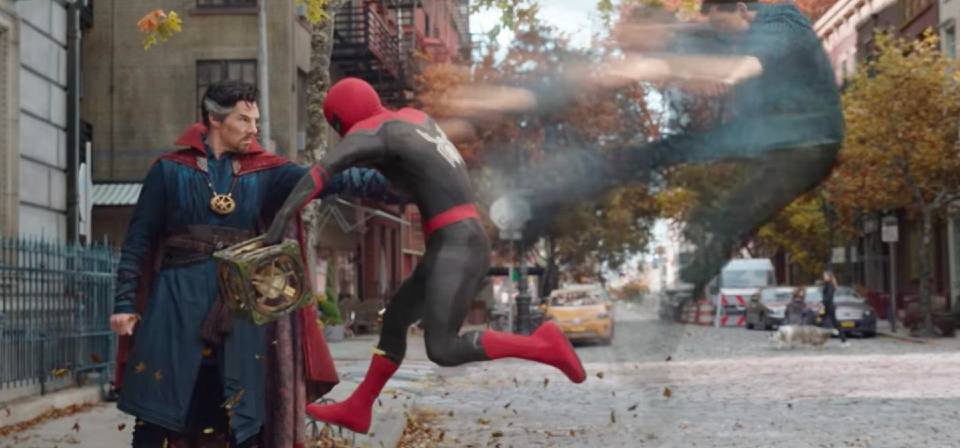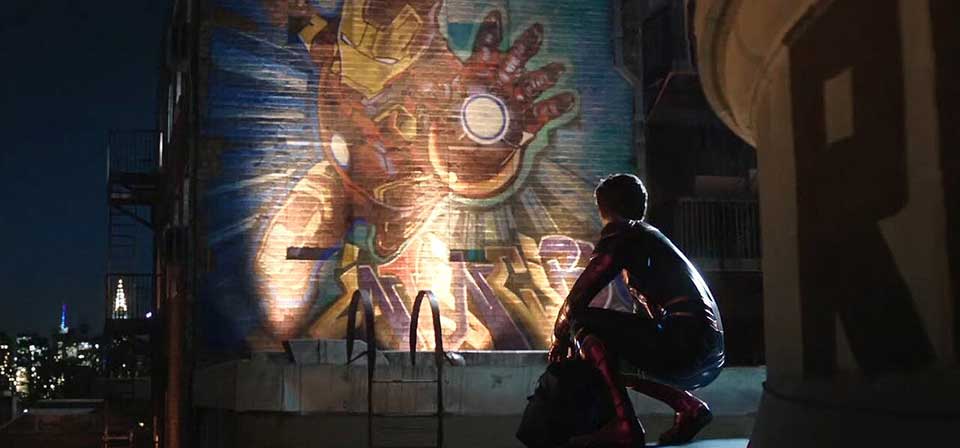Spider-Man: Homecoming (2017)
No one almost destroys the universe or the planet, or even demolishes a large European city or a sizable chunk of a New York borough, in Jon Watts’ Spider-Man: Homecoming.
That’s not to say there’s no significant property damage, but compared to the excesses that have become de rigueur in the Disney-owned Marvel Cinematic Universe, Homecoming is a downright low-key affair, entirely appropriately for a hero who’s a high-school sophomore.
Caveat Spectator
Stylized action violence and menace; frequent crude language and brief, unnecessarily crude sexually themed humor.Even the villain runs a relatively small-scale operation intentionally under the radar of the high-powered titans who now protect the planet from existential threats. What he’s messing with is something the Avengers would be interested in if it came to their attention, though he might be a little beneath their direct involvement. Is he out of the league of a friendly neighborhood Spider-Man? That is the question.
Tom Holland, who debuted as the webslinger in Captain America: Civil War, is easily the most winsome big-screen Spider-Man to date — or, rather, the most winsome Peter Parker.
Homecoming doesn’t top Sam Raimi’s Spider-Man 2, pitting Tobey Maguire’s Spidey against Alfred Molina’s Doctor Octopus, as the best Spider-Man movie to date, and one of the best comic-book movies of all time.
But Raimi’s trilogy, whatever else it did, wasn’t very interested in fleshing out the title character in either of his dual identities. Maguire’s Peter Parker was basically a stand-in for Spider-Man fans, down to the gag in Spider-Man 2 where he learns to his chagrin that Aunt May has sold his comic-book collection without telling him. (The horror!)
The rebooted Amazing Spider-Man and Amazing Spider-Man 2 movies, directed by Marc Webb, weren’t as good as Raimi’s films, but the character played by Andrew Garfield was more interesting than the one played by Maguire. If Garfield’s Peter Parker had an oddly stalkerish side, the second film in particular offered the best big-screen realization to date of Spider-Man’s masked public persona and the heroic role-playing it involves.
I still think Garfield is the best version so far of the man in the mask — but when the costume is off, I’ll take Holland in a New York minute, and specifically in a Forest Hills, Queens minute. (Holland’s is the first Peter I’ve seen in any medium who actually speaks with a Queens accent, which the London-born actor manages very well.)
To be fair, this Peter is still growing into his costumed role — and the 15-year-old sophomore has farther to go than the older characters played by Maguire and Garfield. (Holland was 19 when he first put on the suit; Maguire was 26 and Garfield 27.) Marisa Tomei is also obviously the youngest, most attractive Aunt May ever — so much so that it’s a running gag — but that’s a different story.
This Peter isn’t just inexperienced and unsure of himself, he’s also overawed by the costumed legends in whose shadow he swings. Above all, he idolizes Iron Man, Tony Stark himself, hero to tech nerds everywhere, who recruited him for a special mission in Civil War and equipped him with a snazzy new suit in place of the all-too-homespun outfit he’d originally worn.
This take on Spider-Man — the new kid on the block amid super-soldiers and gods and iron men, eager to play with the big boys — is unlike any previous incarnation of the character in any medium, print or screen. Spider-Man has long been Marvel’s best-known, most iconic character, and has always been among the top tier of the comics’ flagship heroes.
It’s an interesting twist, but something’s missing: something essential to the character. For this threeboot the filmmakers wisely decided that another rehearsal of Peter’s origin story wasn’t necessary — but one element that’s essential to who Spider-Man is (an element notably botched in the Garfield films) should have been mentioned.
Perhaps it could have been handled in an exchange with Tony, or with an important character who accidentally discovers Peter’s dual identity early on. Why does Peter do what he does? Why is it so important to him? Asked about this, Peter could explain: There was this time I could have done something, and I didn’t, and I would give anything to do that over. (The classic line about power and responsibility should be here somewhere, even if only, say, in an account password.)
Peter’s junior-hero status in the MCU is an ironic side effect of his larger celebrity. Like a few other premier Marvel properties (the X-Men, the Fantastic Four), film rights for Spider-Man were too valuable to wait for Marvel Studios to get their act together and were sold long ago to another studio, in this case Sony, which released the Raimi and Webb films.
Spidey’s MCU homecoming is thus the outcome of tenuous negotiations and collaboration between Disney and Sony. Sony permitted Spidey to appear in Disney’s Captain America: Civil War, and Disney allowed Robert Downy Jr.’s Iron Man (and, in a somewhat self-satirizing turn, Chris Evans’ Captain America) to appear in Homecoming, which is distributed not by Disney but by Sony — the first non-Disney MCU movie.
That might be inside baseball, but from the outset Homecoming expects viewers to be true fans. You’re expected to recognize the aftermath of the Chitauri attack on New York from The Avengers in an early scene and some offbeat footage offering additional perspective on the airport battle royale from Captain America: Civil War. If that last sentence leaves you even slightly lost, you’re not exactly the target audience for Spider-Man: Homecoming, but five or ten minutes in you should be fine anyway.
Sometimes Homecoming seems a little too aware of its fans. I do like Peter’s diverse group of peers at Midtown Science High, some based on existing characters who were all originally preppy white kids.
For example, Pete’s classmate crush Liz is played by black actress Laura Harrier (the character has also been Latina in The CW’s animated The Spectacular Spider-Man).
Fine. But why is Peter’s overweight, nerdy best friend — an invaluable and very funny character played by Jacob Batalon, a Hawaiian-raised actor of Filipino descent — named “Ned,” after an utterly different character who was never a high-school peer of Peter’s?
Why hang the handle “Flash Thompson” on an obnoxious non-jock played by Tony Revolori, whose parents are Guatemalan? How many brown kids in Queens are called “Ned,” let alone “Flash”? Why not just give more plausible, less dated names to what are essentially brand-new characters? (I like what they do with Zendaya’s character, an awkward, woke young woman whose name alludes to a well-known character without identifying the two.)
The first two-thirds of Homecoming are kind of shaggy and episodic, with a lot of self-effacing humor and no central conflict. Peter’s high-tech spider-suit is occasionally as much foil and antagonist as anything — an ever-present link to and icon of Stark, but also a tether keeping him in check.
Not quite over all this looms Michael Keaton’s angry working-class salvage contractor-turned-small-time weapons dealer. His name is Adrian Toomes, and I don’t think he’s ever actually called the Vulture, but Keaton’s low-key menace makes him a compelling presence — easily the only MCU villain who could hold a candle to Tom Hiddleston’s florid Loki.
Predictably, the movie clicks into relative high gear in the third act, a high-flying action finale that doesn’t exactly maximize Spidey’s skills set, which you could view as a mistake or an inspired choice, I guess.
Then comes a feel-good denouement that doesn’t feel quite thought out. Peter is congratulated for doing precisely what he supposedly shouldn’t have been doing; and while it’s true that he succeeded, it was a very near thing, and the cost of failure would have been disastrous. Then Peter makes a self-effacing, ostensibly mature decision, although it isn’t explained in a way that entirely makes sense.
The upshot is another good-enough Marvel movie that is less than the sum of its parts, a crowd-pleaser with many fine scenes but no great ones. The novelty of this Spider-Man in this universe is enough to make it work for now. What will they come up with to make the next one work? Something, probably.
Related

Spider-Man: No Way Home (2021)
Not so long ago, a movie like John Watts’ Spider-Man: No Way Home would definitely have prompted me to open my review by dubbing it, if not the best Spider-Man movie ever, at any rate the most Spider-Man movie ever.

Spider-Man: Far From Home (2019)
Tony, Tony, Tony. How can we miss you if you won’t go away?
Recent
- Benoit Blanc goes to church: Mysteries and faith in Wake Up Dead Man
- Are there too many Jesus movies?
- Antidote to the digital revolution: Carlo Acutis: Roadmap to Reality
- “Not I, But God”: Interview with Carlo Acutis: Roadmap to Reality director Tim Moriarty
- Gunn’s Superman is silly and sincere, and that’s good. It could be smarter.
Home Video
Copyright © 2000– Steven D. Greydanus. All rights reserved.